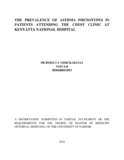| dc.contributor.author | Karanja, Rebecca N | |
| dc.date.accessioned | 2016-11-17T08:59:50Z | |
| dc.date.available | 2016-11-17T08:59:50Z | |
| dc.date.issued | 2016 | |
| dc.identifier.uri | http://hdl.handle.net/11295/97491 | |
| dc.description.abstract | Background: Asthma is a heterogeneous disease characterized by distinct inflammatory and
clinical phenotypes. Knowledge of these phenotypes enables individual patient targeted
treatment resulting in better control leading to a reduction in treatment costs.
Objective: To determine the prevalence of asthma phenotypes among adult asthmatics attending
the chest out-patient clinic at Kenyatta National Hospital.
Methodology: The study was a cross-sectional, descriptive study carried out on asthma patients
attending chest clinic at KNH. The inclusion criteria was asthmatic patients, aged 13 years and
above and had provided an informed consent/assent. The inflammatory phenotypes were
determined using inflammatory cells in sputum. The clinical phenotypes were associated
comorbidities which were determined from the case notes.
Data Management: Data was analyzed using SPSS 21.0 software. Continuous data was
analyzed into means and medians. Categorical data which included the asthma phenotypes and
spirometry findings was presented as percentages. The prevalence of asthma phenotypes was
analyzed as proportions using 95% CI. The results from spirometry were graded as mild,
moderate, severe and very severe obstruction based on the spirometry findings of FEV1 and
were presented as percentages.
Results: Eighty one (81) asthma patients with an average age of 50.1 years and female
predominance of 76.5% were studied. The prevalence of inflammatory phenotypes was
paucigranulocytic (84%), mixed granulocytic (8.6%), neutrophilic (7.4%) and eosinophilic (0%).
The prevalence of clinical phenotypes was allergic rhinitis (76.5%), atopy (67.9%) and GERD
(54.3%).
Conclusion: This study shows majorly paucigranulocytic phenotype which commonly has no
target therapy, making routine use of inflammatory phenotyping in our patients not beneficial.
Among the clinical phenotypes allergic rhinitis was the predominant clinical phenotype. | en_US |
| dc.language.iso | en | en_US |
| dc.publisher | University of Nairobi | en_US |
| dc.rights | Attribution-NonCommercial-NoDerivs 3.0 United States | * |
| dc.rights.uri | http://creativecommons.org/licenses/by-nc-nd/3.0/us/ | * |
| dc.title | The prevalence of asthma phenotypes in patients attending the chest clinic at Kenyatta National Hospital | en_US |
| dc.type | Thesis | en_US |
| dc.description.department | a
Department of Psychiatry, University of Nairobi, ; bDepartment of Mental Health, School of Medicine,
Moi University, Eldoret, Kenya | |



